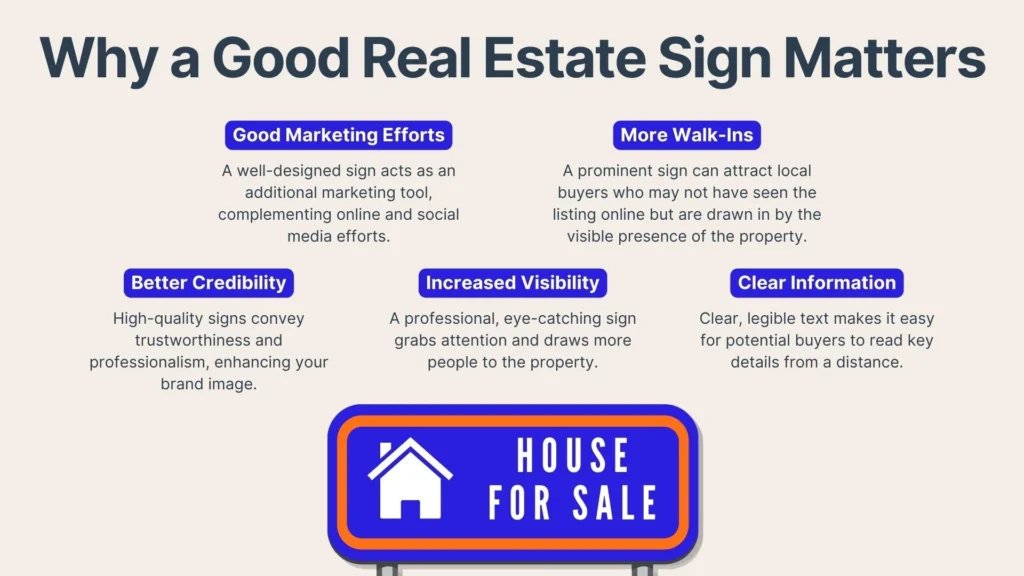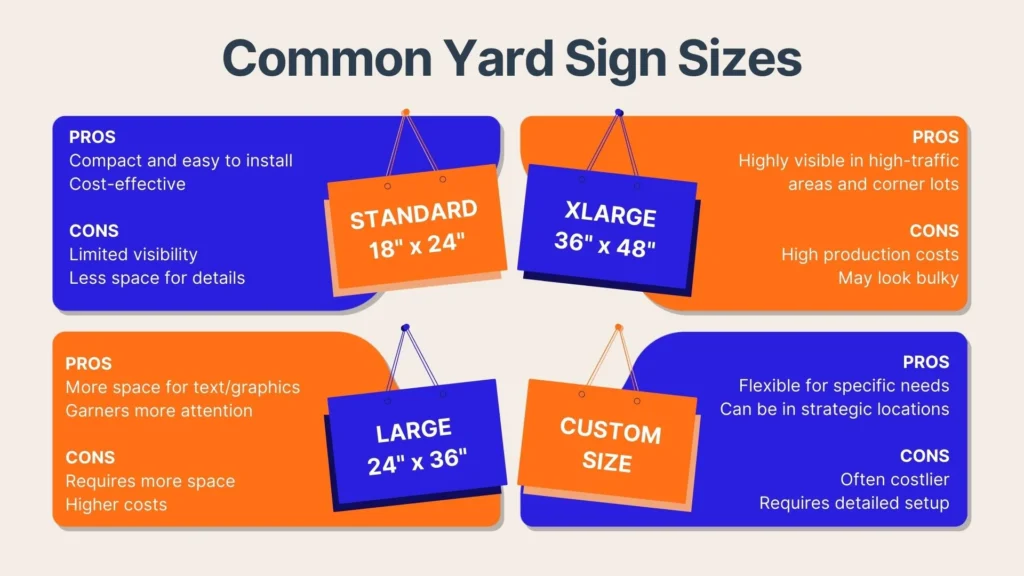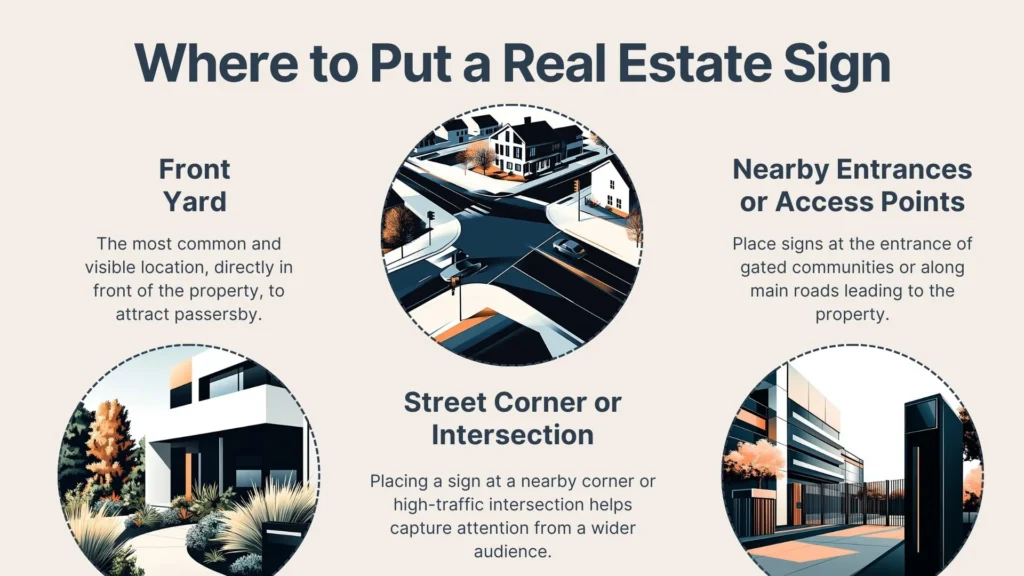Putting up a real estate sign might look simple, but getting it just right requires a touch of strategy. Whether you’re a veteran agent or new to the field, your sign should grab attention, share essential details, and radiate professionalism at a glance. By focusing on the design, placement, and a few other clever tactics, you’ll give your listing a standout presence that truly shines.
Before we get into the specifics of what goes on your sign, let’s talk about why a top-quality display matters so much. It’s more than a piece of cardboard on the lawn – it’s often the very first impression buyers have of a property.
Why Is A Good Real Estate Sign Important?
A well-designed sign acts like a silent salesperson, attracting potential buyers around the clock while you handle deals.
It’s often the first thing people notice, shaping their impression of the property – and you as a seller. According to the National Association of Realtors (2023), 20% of buyers first discover a home through a for-sale sign, 32% link sign quality to an agent’s professionalism, and 60% still rely on signs in suburban areas.
Investing in a sturdy, eye-catching display ensures you don’t miss out on valuable local leads. Now, let’s look at the core elements that make a real estate sign truly effective.

Key Elements Of An Effective Real Estate Sign
We know why a good sign matters. Let’s dive into what makes a sign truly stand out—grabbing attention both figuratively and, at times, literally.
Visibility (High-Traffic Placement)
Your first step is getting the sign noticed. You can have the most stunning layout imaginable, but if it’s hidden behind shrubs or placed on a low-traffic side street, it won’t matter. Seek spots near intersections or main roads where cars and pedestrians often pass.
Make sure it’s elevated enough to avoid being blocked by fences or parked vehicles, and if possible, place it at an angle for maximum exposure from multiple directions.
Eye-Catching Design
Crisp logos, bold graphics, and a professional color palette can help your sign stand out against the backdrop of other listings. You don’t need to go overboard with busy patterns – keep the design cohesive.
Think about your brand identity: if you consistently use certain shades or a signature style, integrate these elements into your sign for better recognition.
Readability (Large, Clear Fonts)
Big, legible text is crucial. Passing drivers often have mere seconds to glance at your sign, so use clear fonts that can be read at a distance.
Script or overly stylized typefaces might look pretty, but they can also slow people down or confuse them. Opt for large, simple lettering that highlights your brokerage or personal brand name, along with key details about the home.
Essential Property Details (Mention Clear Contact Info)
Ever see a real estate sign with no phone number, or a phone number so small you can’t read it? Don’t let that be you.
At minimum, list a main phone number or email address, and make it large enough to be seen. Many agents also add their headshots, making the sign feel more personal. If you decide to include an image, ensure it’s high-resolution and properly positioned so as not to overshadow the property’s details.
Choosing The Right Size For Your Sign
Now that you’ve pinned down the must-haves, it’s time to talk about dimensions. The size of your sign can impact visibility, cost, and even the neighborhood’s aesthetic requirements.
- Standard Sizes: Real estate signs commonly range from 18" x 24" to 24" x 36". These are often enough for standard home listings, providing enough space for vital info without overwhelming a front yard.
- Custom Sizes For Impact: Sometimes you want to make a statement, especially for luxury or high-value properties. In these cases, oversized signs (3 feet wide or more) can turn heads, though they may come with higher costs and might need special permits.

Remember to consider local regulations or homeowners’ association guidelines when selecting the size. The last thing you want is to invest in a dazzling sign that’s taken down due to code violations.
Essential Information On A Real Estate Sign
You’ve got the layout and dimensions sorted out. Now, let’s dive deeper into the specific details every successful real estate sign should include. This is where you transform curiosity into genuine interest, all by sharing just enough to intrigue potential buyers.
Property Details
At the very least, list the property’s main selling point like “Single-Family Home” or “Townhouse” so people know what type of residence is being advertised. If the house has unique features (pool, large backyard, or newly renovated kitchen), a brief mention can pique interest.
Price
Including the price or a price range, can be a powerful tool for filtering out leads who aren’t serious or who can’t meet that range. Some agents prefer to omit the price to encourage calls, but there’s an argument to be made for clear transparency, which can speed up the buyer qualification process.
Bedrooms And Bathrooms
This is basic info, but it matters. “4 Bed, 3 Bath” or “2 Bed, 1.5 Bath” gives people a quick sense of the home’s size. This detail also answers one of the top questions prospective buyers tend to have, saving everyone time.
Contact Information (Email Or Website, QR Code If Any)
Contact details are the lifeline connecting potential buyers to you. Include a phone number and professional email address.
You could also consider adding a QR code that, when scanned, leads directly to the listing page or your realtor site. Keep the QR code large enough to be scanned easily from a short distance but not so big that it overwhelms your design.
Direct Link To Listing
While you can’t exactly print a clickable link on a sign, you can always add a short, easy-to-remember URL that leads potential buyers to the property page. Pairing this with a QR code is even better as it appeals to both tech-savvy buyers who love scanning and those who prefer typing it in manually.
To take it a step further, you can try PropBox, a tool that will help you make the listing process seamless from start to finish. With AI-powered Listing Description Generation, you’ll get optimized, engaging property descriptions that highlight key features based on your input.
Best Materials For Real Estate Signs
A well-designed sign is only as good as the material it’s printed on. You need something durable that maintains a professional look in all kinds of weather, day or night. Below are a few popular options:
- Corrugated Plastic (Coroplast): This is lightweight, cost-effective, and great for short-term listings. It can fade over time but works well for open house announcements or temporary signage.
- Aluminum: Known for its longevity and polished appearance. Aluminum signs resist rust and look sleek, making them a popular choice for many realtors.
- PVC or Acrylic: These materials can give a sophisticated, high-gloss finish. They’re a bit heavier than corrugated plastic but still easy to handle and clean.
- Reflective Finishes: If you’re concerned about visibility after sunset, using reflective vinyl or coatings can help. This feature can turn headlights into an ally, ensuring your sign remains readable even at night.

Pick a material suited to your local weather, be it rain, extreme heat, or gusty winds. Spending a bit more on sturdier options can save you from future replacements.
Designing Your Sign For Maximum Impact
Picking materials and listing details are just half the battle. How you arrange these elements on your sign plays a huge role in whether people engage with your message.
High-Contrast Colors
Bold color combinations grab attention from afar. Dark text on a light background (or vice versa) makes key details stand out. Stick to a few complementary colors to keep it visually clear—too many hues can overwhelm potential buyers.
Visibility At A Distance
Consider how far your target audience might be from the sign. Are they walking on a sidewalk, driving by at 40 mph, or zooming past on a highway? Font sizes and design elements should be scaled accordingly. You might need more spacing between letters and fewer words overall to ensure that everything is readable in motion.
Keep It Simple And Clear
Minimalism is your friend. Too many graphics or text boxes can make your sign look cluttered. People should be able to grasp the key info like the property’s size, price, and contact details within a couple of seconds. White space (or any open, unprinted area) can actually help your primary message stand out.
Avoid Clutter
It can be tempting to pack every highlight or amenity onto the sign, but this can overwhelm prospective buyers. You want just enough info to pique interest. Remember: You have other channels like your website or in-person tours – to showcase the full story. A neat, streamlined sign feels far more inviting than a text-heavy poster.
Optimal Placement Of Your Real Estate Sign
You’ve nailed design and content. Now, where exactly should the sign go? It might seem trivial, but placement can make or break your marketing efforts:
- Front Yard Visibility: Typically, you’ll want to place the sign in the front yard, near the sidewalk, but not so close that it obstructs walking paths.
- Street Corners: If allowed, consider placing signs at nearby intersections or corners leading to the property. This can guide people to your listing from the main roads.
- Open House Events: When hosting an open house, use multiple signs to create a path, directing traffic from major streets to the home. Additional directional arrows can be helpful.
Keep in mind local regulations on sign placement. Some cities have strict rules about how far a sign must sit from the curb, or how many signs you can display. Stick to the rules, dodge fines, and keep your sign up for the entire listing.

Measuring The Effectiveness Of Your Sign
How do you know if your carefully designed sign is actually doing its job? Tracking engagement helps you fine-tune future marketing efforts.
Inquiry Tracking (Phone Calls And Email; QR Code Scans)
One straightforward method is to monitor incoming calls or emails and ask, “How did you hear about this property?” If you include a unique phone number on the sign or a specific email address, you can track leads directly. For QR codes, you can use analytics to see how many scans each sign generates.
This real-time data shows you which properties or sign styles are most appealing.
Digital Engagement (Website Visits; Online Listing Traffic)
If you’re using short URLs or vanity domain links, check your web analytics to see how many people are visiting from each sign’s link. Notice a spike in page views after placing a new sign? That’s a good indicator your design is working. Many realtors keep spreadsheets or use software to correlate sign locations with spikes in digital traffic.
Conclusion
A great real estate sign is more than just your contact info slapped on a board. It’s your first chance to catch a buyer’s eye, keep the design simple, use durable materials, and ensure the message is straightforward. And if you track how many calls or inquiries come in, you’ll know right away if it’s doing its job. Whether you’re selling a snug starter home or a sprawling estate, a standout sign sets the tone and boosts your credibility.
When you’re ready to tackle the rest of your sale, PropBox makes the FSBO process easier than ever. Our platform uses AI to create eye-catching listings, helps coordinate professional photos and staging, and automatically syndicates your property across major platforms.
Say goodbye to steep commissions and hello to keeping more of your hard-earned profits. If you want a faster, smoother path to closing, let PropBox handle the heavy lifting.
